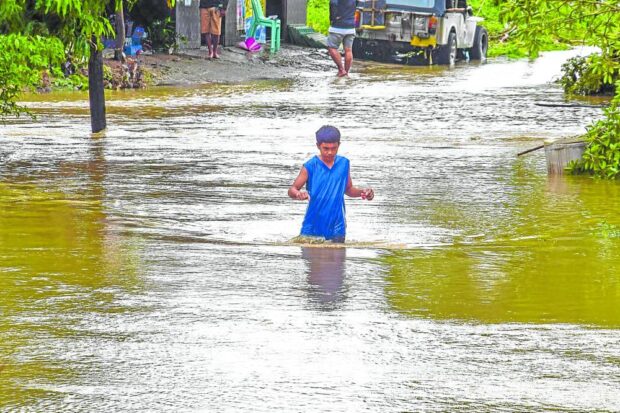
UNSAFE A boy wades through a flooded area at Barangay Bil-loca in Batac City, Ilocos Norte, in this photo taken on July 28, a day after Typhoon Egay (international name: Doksuri) headed out of the Philippines, leaving behind widespread destruction in northern Luzon last week. —PHOTO COURTESY OF VPI TRAVEL ILOCOS
LAOAG CITY — Leptospirosis and dengue claimed the lives of 21 people in the Ilocos region this year, prompting the regional Department of Health (DOH) to warn residents in flood-affected areas to be extra careful of these deadly diseases that are prevalent this rainy season.
In a statement on Friday, the regional DOH urged the public to avoid wading through floodwaters due to potential contamination with water-borne diseases, influenza, leptospirosis and dengue (WILD) fever, which are caused by a variety of bacterial, viral and parasitic organisms that may thrive in flooded areas.
Since January this year, at least nine people in the region have died because of leptospirosis, which has infected 45 others. Dengue also caused the deaths of 12 individuals, while around 1,957 residents were infected.
Dr. Paula Paz Sydiongco, DOH regional director, said that flooding caused by torrential rains in recent days in Luzon posed an “increased risk in the transmission of vector-borne diseases such as dengue, malaria, and influenza, which are common during this period.”
Sydiongco feared that floodwaters may also be contaminated with the Leptospira bacteria, which causes leptospirosis.
“Leptospirosis is not only acquired from the urine of rodents, but also from other infected animals, such as cows, pigs and dogs. It’s better to avoid the wading through floodwater if necessary,” added Sydiongco.
As of Friday, parts of the Ilocos and Central Luzon regions continued to reel from widespread flooding, loss of crops, and destruction of homes, properties and vital infrastructure caused by last week’s onslaught of Typhoon Egay (international name: Doksuri) and the enhanced southwest monsoon that pummeled northern Luzon.
In Ilocos, the cities of Laoag and Dagupan remained submerged in floodwater.
The World Health Organization said that leptospirosis is a “disease of epidemic potential, especially after heavy rainfall or flooding.”
Code white
To limit exposure to leptospirosis, the regional DOH advised residents to wear protective gear such as boots, raincoats and umbrellas when going out in the rain.
“Wash feet immediately with clean water and soap after being in contact with floodwater,” said Sydiongco.
Sydiongco said all public health facilities in the region have been on code white status, allowing health workers to respond to emergencies and provide immediate assistance and guidance in health emergency response situations.
The DOH Ilocos said that health facilities have already activated a “fast lane” to immediately provide treatment to individuals who are possibly exposed to WILD diseases.
Equipment and other medical supplies, such as insecticides, larvicides, insecticide-treated screens, dengue NS1 (nonstructural protein 1) rapid diagnostic tests, antigen and antibody tests, oral rehydration salt, paracetamol, and prophylactic antibiotics, have been prepositioned in all provincial DOH and health offices, said Sydiongco.